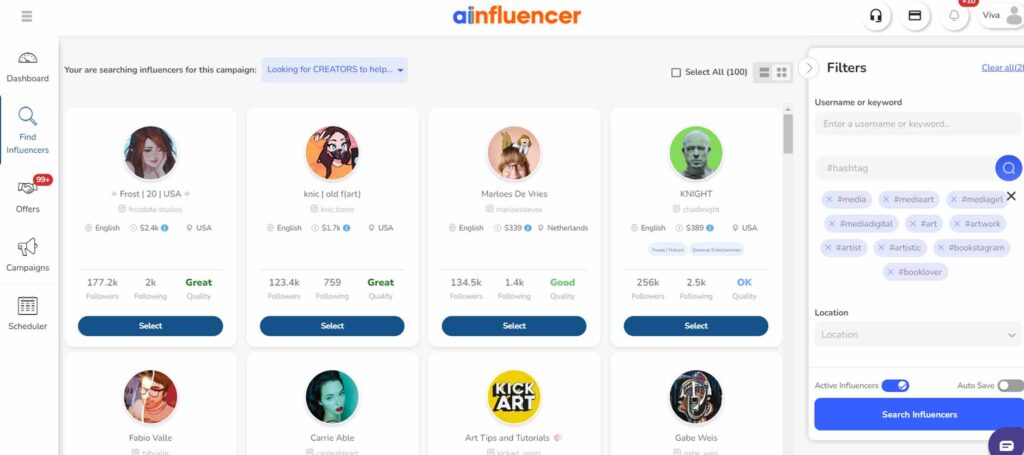There is no doubt that advertising is an inseparable part of every business’s marketing strategy. It plays a pivotal role in helping companies achieve their goals and reach their target audience effectively. However, the success of any advertising campaign heavily relies on the allocation and management of the advertising budget.
That’s why you should know how to allocate this budget, optimize and manage it to maximize return on investment (ROI).
In this article, we’re going to tell you what the advertising budget is and how you can optimize its costs.
What Is an Advertising Budget?
Every business should assign a budget to promote its products, services, or brand through various marketing channels, including social media marketing or print media. This amount is known as the advertising budget, which plays a significant role in the company’s marketing plan.
This budget represents a crucial investment in generating brand awareness, driving customer acquisition, and ultimately boosting sales. However, preparing an effective advertising budget strategy requires a comprehensive understanding of various factors and considerations.
Planning out your budget allows you to decide on the advertisement duration and the number of channels to set your marketing. If you don’t determine this budget before starting your marketing strategy, you may put your business at risk of overspending money or losing track of expenses, which may prevent your business from growing.
If you want to dedicate part of your budget to influencer marketing, which is one of the modern and trending marketing methods on social media, check Ainfluencer. Our marketplace can connect brands and influencers quickly and effortlessly.

Sign up on Ainfluencer for free and find the top influencers for marketing your products or services.
What to Include in an Advertising Budget?
While setting a budget for your advertising, the most important thing to consider is how to determine it and what to include. Depending on your goals and strategies, you may need to consider different expenses in your budget.

Here are some common items you may want to include in your advertising budget:
1. Market Research
Before forming any marketing plan, you should gather information about your competitors and customers to identify which media channels your target audiences use. You can’t determine an advertising budget if you don’t know where your customers spend most of their time.
Furthermore, understanding your customers’ characteristics can also give you an idea about the type of advertisement that is appealing to them. Therefore, this step can be game-changing for your business.
2. Creative Development
Based on the channels you choose for advertisement, you need different ad materials, such as copy, graphics, videos, audio, etc. This product comes with a cost. You should also decide how much money you want to allocate to this step. Do you need to hire professionals, or is it better to outsource the development step?
3. Media Buying
From traditional offline ads to creative and modern online ads, you should pay an amount of your budget for purchasing the ad on the chosen media channels. For example, printing an ad on a journal, or placing a banner or contextual ad on a website are considered some ways of media buying. The other methods include TV stations, radio stations, newspapers, magazines, etc.
One thing that is trending in the world of advertisement is social media marketing. You can either incorporate social media sites, such as Snapchat, Instagram, and TikTok, or start influencer marketing by collaborating with top influencers on these networks.
4. Media Production
You may need to create audio or visual products for various purposes and formats, such as films, commercials, podcasts, videos, images, texts, and audio. Media production is the process of preparing and delivering these products for different channels.
5. Agency Fees
Sometimes you need the help of other marketing companies and agencies to manage your ad campaigns. For example, you can work with a social media agency to manage your social media accounts and advertisement or find influencers to collaborate with.
A marketing agency offers different services, such as media planning, creative development, media buying, media production, etc. However, the cost of each service is separated from the fee you pay to these agencies.
6. Other Expenses
Always consider a limited budget for extra expenses you may have to pay, such as legal fees, taxes, licenses, or any other expenses you haven’t planned yet.
You may also need some tools to improve your ads. For example, you may need to buy a hashtag generator tool to publish better posts on Instagram or TikTok and be discovered by more people. That’s the extra expenses you should consider in your budget.
Although you may want to reduce advertising expenses, buying some tools can help you perform better on the channels you choose. Tools can speed up your work and reduce errors.
Advertising Budget Optimization Techniques
Now that we know what to include in our advertising budget plan, we should learn techniques to optimize this budget and reduce costs. Optimizing the advertising budget means spending money wisely and effectively to achieve our marketing goals.

You can easily optimize this budget with the following tips:
1. Identify the Areas for Cost Reduction
Your brand may not need all types of advertisements. Therefore, cancel the ads that don’t have any benefit for your brand. You can also do the production steps inside your company and reduce the costs of outsourcing production.
2. Segment and Target Your Audience
You can divide your potential customers into different groups based on their characteristics, such as demographics, psychographics, behavior, or needs. This segmentation can help you decide which media will have a better result for you and target that segment for your advertisement.
3. Review Your Marketing Goals and Objectives
The first time you run an ad, you may not predict how effective it will be. But you have a marketing goal, which means you want to achieve something. What do you want to get from this ad? For example, you may want to boost your website clicks or increase your Instagram engagement and followers.
After the finish of the ad duration, you should review your goals and check that with the result of the ad. Have you reached your goal? Checking these numbers can help you decide if you are on the right road to success or if you need to change the method or channel of advertisement.
Meanwhile, you should have a clear idea of what you want to accomplish with your advertising campaigns. Your goals should be specific, measurable, achievable, relevant, and time-bound (SMART).
For example, you may want to increase your website traffic by 20% in the next quarter or generate 100 leads per month for your new product. Make it as specific and precise as you can.
4. Test and Optimize Your Ads
The previous step gives you ideas about how to optimize your current ads. If you can edit and reapply the ad, you will not have to pay the price of ad production anymore. Thus, you will save money.
Advertising Budgets Management
Until now, we understood what we should include in our advertising budget plan, and how to optimize it. But there is still one important thing to do: budget management.
This step is also crucial for your business to succeed in budgeting. How to manage this budget?
1. Tracking and Monitoring Expenses
It is necessary to monitor the advertising expenses to avoid overspending money. You can use a marketing budget template to track every payment. Marketing automation tools can also help you monitor and optimize your budget and reduce errors.
2. Budget Adjustments Based on Campaign Performance
Track your spending by category, channel, campaign, and vendor. Then, compare it to your budget allocation and expected ROI.
3. Allocating Resources Efficiently
Review your advertising expenses regularly to see what channels have the most ROI for your business. Then, you can focus on that channel and use your resource only on that advertisement.
Bottom Line
Setting an advertising budget is the first step every business should take to start its marketing because ads can help you elevate your brand and represent it to your target audience. You should also note that no one can tell you how much you should spend on advertising or what is a good budget. It all depends on your business and goals. But the steps to optimize or monitor this budget are almost the same for every business.
You should set your marketing goal, do market research, decide on the channels to run ads, and then select a budget based on that. This process will repeat, and some of its steps might change for optimization. Therefore, don’t rush on these steps. The more time you spend researching; the better result you will have.
It is recommended to consider social media marketing in your advertising costs because you can find most of your audiences online. To find them and turn them into your customers, we offer you our free DIY marketplace. Sign up on Ainfluencer and access the list of top influencers on Instagram and TikTok. We make it easier to discover the right influencer for your market because you can search influencers based on category, gender, location, and hashtags they use. Grow your market with only a few clicks.
FAQs
First, you should define your marketing budget and then divide it into different parts. The key factor is that your marketing budget should usually be almost 8 percent of your annual sales revenue. Then, you can dedicate between 15 to 20 percent of this budget to advertising. However, you should note that there is no one-size-fits-all formula for determining the budget for advertising, it depends on the business size and goal.
Market research can tell you a lot about your target audiences and competitors. When you understand your audiences’ needs, characteristics, age, or gender, you can find what is the best advertising channel. For example, if you target youths, influencer marketing on TikTok can have a better result for you.
There is no exact amount for a good ad budget, but a formula can help you decide on your ad budget. The advertising budget dedicates approximately 15% of the total marketing budget to itself. This amount also depends on the business’s annual sales revenue. Additionally, if you want to run ads on several channels, this budget will be divided into different parts.
They are not the same, but they go the same way. An advertising budget is a subset of a marketing budget. It means you spend part of the marketing budget on ads. A marketing budget includes other costs rather than an ad budget, such as pricing, distribution, customer service, and public relations. On the other hand, an ad budget is specifically focused on the costs of creating and placing ads in various media channels.
![You are currently viewing Advertising Budget: How to Optimize and Manage It? [in 2024]](https://blog.ainfluencer.com/wp-content/uploads/2023/05/advertisement-budget.jpg)





